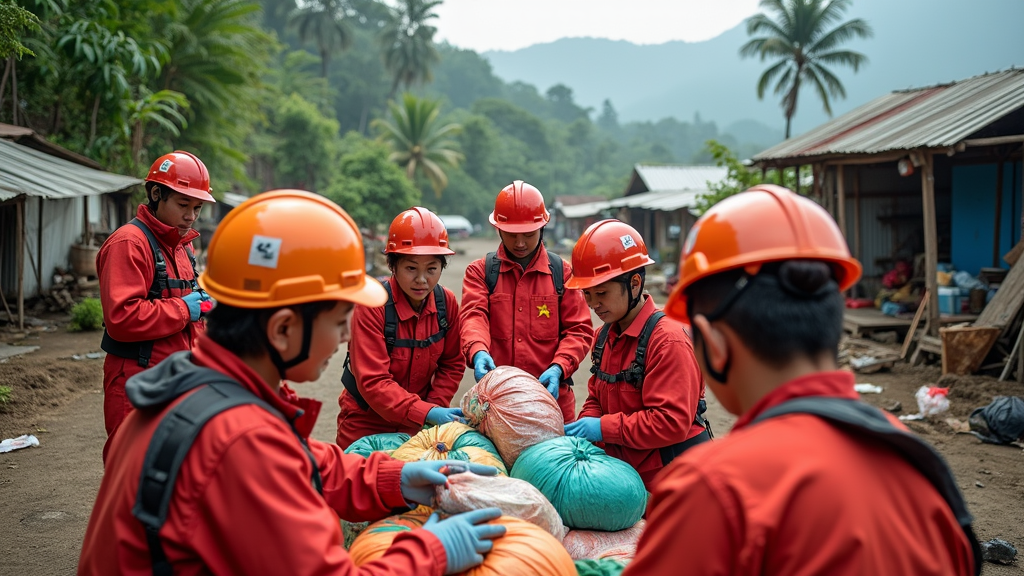Future of U.S.-Ukraine Alliances: Power, Progress, and Promise
Renewed Alliances: Ukraine and U.S. Partnerships in 2025
Recent developments rippling through the international political arena have left many wondering: Has Ukraine finally convinced Washington to stand by Kyiv’s side? As the world watches, significant progress in U.S.-Ukraine relations showcases a narrative infused with hope, resilience, and strategic cooperation. This partnership is not merely rooted in moments of desperation or fleeting gestures of solidarity. No, it is blossoming into a comprehensive alliance characterized by groundbreaking economic agreements, recalibrated military support, and a show of bipartisan political engagement that reverberates from the halls of Capitol Hill to the crowded streets of Kyiv.
Key Signs of Strengthened U.S. Support
Ratified minerals agreement
On May 8, 2025, a monumental shift occurred when Ukraine’s parliament cast 338 votes in favor of the U.S.-Ukraine Reconstruction Investment Fund, signaling a historic moment of unity and shared vision between these two countries. This agreement, the most promising to date, paves the way for a fortified economic relationship as it establishes:
- Joint management of future projects between the two nations
- Clear avenues for U.S. investments through military aid and direct financial contributions.
- A decisive exclusion of Russian-aligned states from participating in reconstruction efforts, a bold step that speaks volumes about Ukraine’s unwavering commitment to sovereignty.
President Zelensky heralded this pact as a beacon of promise, envisioning decades of productive cooperation. As the U.S. International Development Finance Corporation eyes an initial funding request of $2.82 billion to set the wheels of this engine in motion, the optimism is palpable, rising like a phoenix from the ashes of past conflicts.
Military aid recalibration
In tandem with the economic developments, recent military aid adjustments indicate a broader strategic pivot that cannot go unnoticed. Among the most significant moves:
- Plans for the refurbishment and eventual transfer of a Patriot air-defense system from Israel to bolster Ukraine’s defensive capabilities.
- A forthcoming White House initiative aimed at intensifying sanctions against Russia’s economy, affirming the U.S.’s unwavering stance in this clash of ideologies.
- Discussions suggesting future military aid allocations may be integrated into investments associated with the newly minted Reconstruction Fund.
Each of these steps reflects an evolving response to the challenges on the ground—a response encapsulated not merely in equipment and money but in a deep-rooted understanding of mutual survival in an increasingly precarious geopolitical landscape.
Bipartisan Political Engagement
Republican outreach
As the political landscape shifts, bipartisan support appears more crucial than ever. An emblematic encounter recently unfolded when Ukraine’s Chief Rabbi met influential Republican figures, including Congressman Joe Wilson, to stress the pivotal role of sustained support in achieving “Victory of Good over Evil” against oppressive forces. This meeting signifies an acknowledgment that beyond party lines, the urgency of securing Ukrainian sovereignty is recognized broadly.
Administration stance
Reaffirming this commitment, Treasury Secretary Scott Bessent remarked on the ratified agreement as part of Trump’s “tireless efforts to secure lasting peace,” framing the partnership as one of moral imperative intertwined with strategic benefit.
Civil society
The resonance of this commitment is echoed not only in chambers of power but also among the people. A recent mass rally at the Lincoln Memorial exemplified the weighing in of civil society, highlighting grassroots support for Ukraine. This unified voice from the public aims to sustain policies that advocate justice and stability, underpinning the larger framework of governance.
Persistent Challenges
However, romantic notions of unwavering support must be tempered by a firm recognition of the obstacles that remain. Despite the evident progress, gaps still linger:
- The absence of binding U.S. security guarantees in the ratified agreement leaves fundamental questions regarding the nature of the alliance.
- Historical military aid appears to remain insulated from future fund contributions, creating a scenario of uncertainty.
- Furthermore, ongoing tensions regarding timelines for peace negotiations with Russia continue to cast a shadow over the talks of cooperation.
Strategic Context
Understanding this partnership requires a reflection on the delicate balance at play. U.S. priorities—securing mineral access while constraining the influence of both China and Russia—align intricately with Ukraine’s staggering financial needs given the estimated $486 billion necessary for reconstruction (World Bank, 2023). The partnership may at times feel transactional, yet it is threaded with a broader promise—a promise rooted in a shared vision for prosperity amidst hardship.
As Secretary Bessent articulated, the ratified agreement showcases a “commitment to a peace process centered on a free, sovereign Ukraine,” intertwining principles of autonomy with the realities of American economic interests.
While layers of complexity envelop this narrative, each compelling development signals a commitment that grows, deepens, and solidifies over time. Moments branded in conviction become for every citizen, every politician, and every number that graces the column of a financial report an invitation to stand together on this journey, not simply to survive but to thrive. As this chapter unfolds, the foundation laid may serve as a witness to dreams realized and bonds forged in the furnace of history’s trials.
For always fresh news and riveting analysis about ongoing developments, readers can check the dedicated Telegram channel: https://t.me/World_news2035.
Emerging Realities
As the partnership between the U.S. and Ukraine continues to deepen, it becomes increasingly apparent that effective dialogue remains a cornerstone of their relationship. In this evolving scenario, diplomatic discussions are colored by real-world implications, providing opportunities for both nations to air concerns while charting paths toward mutual benefit.
Diplomatic dialogues
Amidst these agreements and commitments, continuous engagement has emerged as an essential element. Ukrainian religious leaders recently met with U.S. lawmakers, fostering connections that transcend traditional political boundaries. These meetings are not merely symbolic; they represent a broader commitment to maintaining support across multiple sectors of society, reinforcing the foundations that underpin the burgeoning relationship between these countries.
Furthermore, ongoing discussions highlight the voices of Ukrainians seeking to articulate their aspirations to leaders in Washington. The emphasis on shared values like democracy and freedom underscores a narrative that transcends mere transactional interactions—this is about forging a dignified alliance. The reaffirmation of cultural connections serves to strengthen the trust that is pivotal in these challenging times.
Long-Term Perspectives
Collective responsibility
As Ukraine endeavors to rebuild in the shadow of ongoing aggression, the weight of collective responsibility grows heavier. The Reconstruction Investment Fund is not merely a financial tool; it embodies the hope and aspirations of millions whose lives have been disrupted. Just as resources must flow into rebuilding infrastructure, so must political will persevere through the uncertainties. A cohesive strategy that champions resilience and mutual dependence will determine not only the fates of these nations but also that of global stability.
America’s role
Continued U.S. support, both military and economic, resonates as a lifeline for Ukraine in its fight for autonomy. Yet as the geopolitical landscape evolves, questions arise regarding America’s long-term role in sustaining this partnership. With the complexities inherent in recovery efforts, officials in Washington must recognize that their commitment now functions as a critical node of stability in Eastern Europe, one that calls for sustained investment and engagement.
Conclusion: A Future of Possibilities
In wrapping up this analysis of the U.S.-Ukraine partnership, the sentiments expressed in Prime Minister Zelensky’s recent remarks echo loudly: this is more than just an agreement—it’s a commitment to a shared future. The road ahead will undoubtedly be strewn with challenges, fraught with the ever-present risk of external pressures and internal divisions. Yet, as barriers are broken down and partnerships are fortified, a new tapestry of cooperation begins to emerge.
Navigating these waters will require patience, resilience, and a steadfast belief in the principles that bind allies together. As this partnership evolves, it paints a picture of hope—a hope that shines brightly amid the clouds of conflict and uncertainty.
For further insights into the unfolding developments, readers can explore this engaging article on Euronews: Has Ukraine finally convinced Washington to stand by Kyiv’s side?.
For always fresh news and riveting analysis about ongoing developments, readers can check the dedicated Telegram channel: Завжди свіжі новини.
The bonds forged in these pivotal moments may well define not only the trajectory of Ukraine but also the role of the U.S. as a guiding presence in an increasingly complex world. As the future unfolds, we stand witness to a story of resilience and cooperation that heralds new beginnings amidst the enduring echoes of past struggles.
latest video
news via inbox
Subscribe to the latest news in the world of politics and technology







